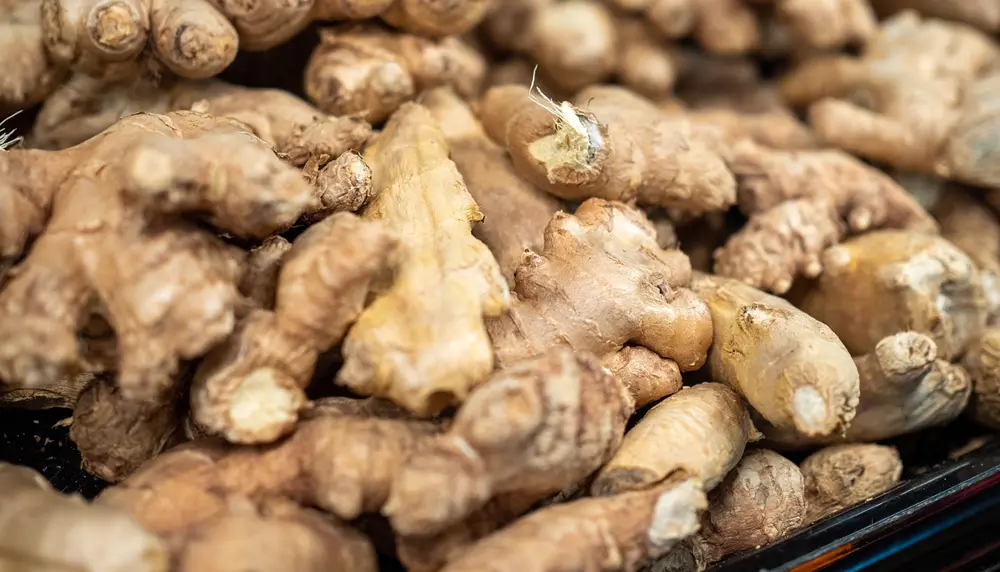
Explore My Crystallised Ginger | A Culinary and Wellness Journey
My journey in the world of business began with ginger – specifically, making crystallised ginger. As a curious food enthusiast, I’m the type who prefers trying out things that are readily available in stores. I’ve even dabbled in making puff pastry from scratch. Though not the greatest result bu still happily edible, I made sausage rolls.
Back in 2017, while living in Canada, I encountered crystallised ginger and that was my light bulb moment. The flavour was palatable, but the excessive sugar content bothered me and I was curious about making it at home.
This marked the beginning of my quest, which naturally started with a Google search – a common approach for many. Eager to learn the process, I delved into the world of homemade crystallised ginger. Numerous results suggested using a mandolin to thinly slice and removing the skin on the ginger. Here’s an example of one of the first pages I checked out, recipe from Daring Gourmet. Eventually, I came across the recipe of a US-based chef named David Lebovitz, known for his culinary expertise on the West Coast of USA. His crystallised ginger recipe intrigued me, which you can find here. What I liked about his recipe was he mentioned about the ginger syrup. Though when I was making the crystallised ginger for the first few times, I didn’t have any syrup leftover in the pot to be using.
To my surprise, the homemade version offered a distinct flavour profile, boasting a vibrant ginger spice kick unlike the perfectly shaped, cubed crystallised ginger. I found myself disheartened by the waste generated from the removing of the skin, especially considering the high fibre content and flavour potential. This aspect prompted me to consider organic varieties. I did see organic ginger from Peru at the Calgary Farmers’ Market and did some further research.
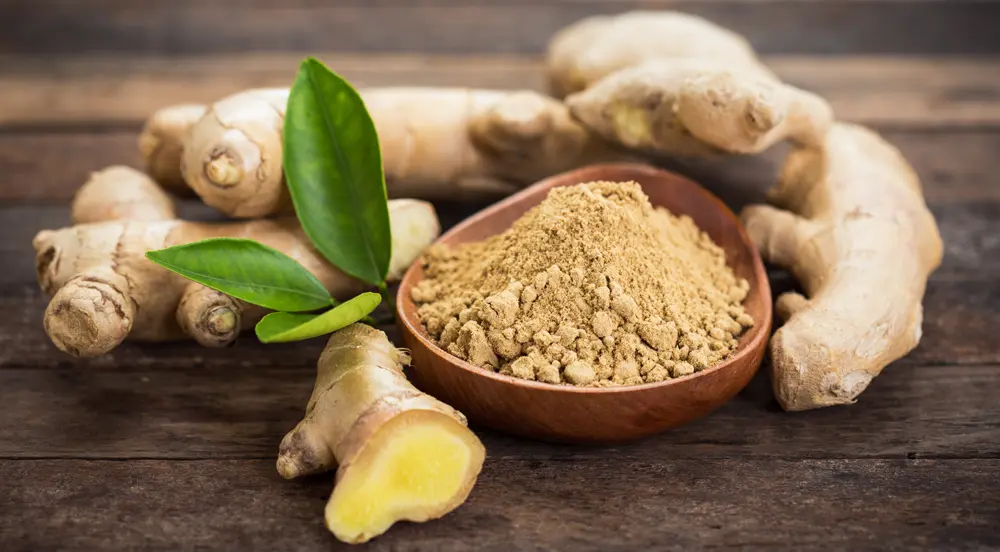
ginger_pregnancy
Of course my google results were different when living in Canada to what google would show me here in Ireland. When I returned to Ireland and once I started looking at commercialising the product. I received some taster feedback and I needed to create a more chewier ginger pieces. After some more searches I came across further information that would help me make the ginger root less fibrous but still oh so good.
As well as the above searches I was looking at the type of ginger and the quality. I was curious of the size and quality of the Peruvian ginger. So once I returned to Ireland, I went looking for some of this golden ginger root. So something to remember if the ginger is nice and yellow that is due to the gingerol concentration, more yellow higher gingerol and goodness, veering towards white/dull colour, low in gingerol.
The commercial crystallised ginger that you see in the supermarkets tend to high have a high volume of sugar per 100g of product, most will range from 75g up to 85g of sugar per 100g of product. Not sure why it is so high when handling such a immune boosting product on its own. I read the below excerpt on how they made the crystallised ginger from a UK business, Suma Wholefoods -
To make sweetened ginger, a number of steps are followed. Firstly, the freshly cut, immature rhizomes are cleaned, then cut into whatever the shape that is needed. Secondly, the ginger is preserved in salt by covering the pieces in salt then covered for 24 hours before the liquid is poured off; next, a fresh load of salt is added, some vinegar is added and the ginger is left to pickle for seven days. Finally, this salted ginger is removed from the brine, washed, then soaked in cold water for two days during which time the water is changed a few times, after which the washed ginger is boiled in water for ten minutes; after this stage, the ginger is boiled in dense sugar syrup several times until the sugary sweetness has impregnated the preserved ginger. For ginger in syrup, the ginger is kept in this dense sugar syrup as preservative. However, for crystallised ginger, it is boiled in the sugar syrup until it has evaporated off further, after which it is drained of the syrup, dried, then rolled in sugar. As much in the spice world, a serious amount of time and labour is expended for very little end value.
You can see it here on this webpage - webpage link
The preparation of the ginger root really losses any beneficial offerings that ginger is so well known for. So it is disappointing to read when seeing about the salting and the addition of the vinegar. I certainly don't do any of those steps to tenderise the root, with research I have been able to take natural steps and produce a far superior product that benefits your health. Obviously the high sugar crystallised ginger has its uses. It's like making good quality chocolate from better sourced ingredients. That is what I am doing with my crystallised ginger.
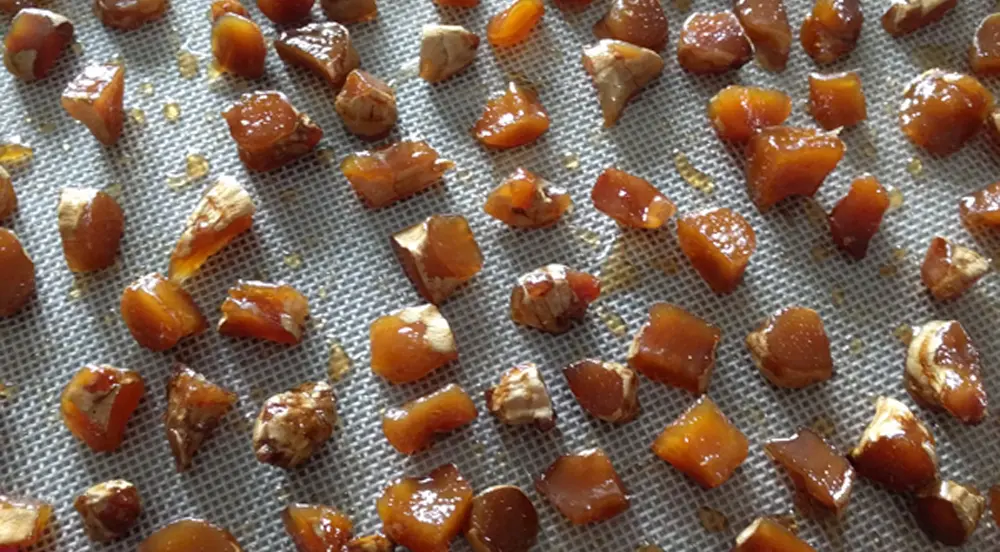
Some pictures of testing drying crystallised ginger. Just some crystallised ginger drying out au natural.
When I was first making the crystallised ginger to sale, the pieces were a bit larger than what I make now. The flavour was certainly a bit overwhelming for consumers at first or just the unexpected strength, as they would have been accustomed to the sugary crystallised ginger cubes you get in the shop. So making them smaller, customer's are able to enjoy more pieces without blowing their heads off with the ginger zing.
Customer's do acclimatise to the zingy ginger flavour and now take it for the ginger benefits which range from joint issues like arthritis as ginger is a powerful anti-inflammatory. I am hearing more customers mention how the crystallised ginger aids their digestion as it eases acid reflux and heartburn, as well as any nausea symptoms.
So the Peruvian ginger is brought into Ireland mostly through the Netherlands and then redistributed around Europe to other suppliers and distribution companies. Of course having Irish grown ginger would be amazing but the growing conditions for a company like my own whose main ingredients is ginger is just unfeasible at the moment. There are some small organic growers who selling small quantities. There is a grower around Limerick who occasionally grow it, New Leaf Urban Farmers and also locally Poppa Dom's Farm near Kilmullen,near Killarney, have had attempts at growing it. Will get more updates on that soon :).
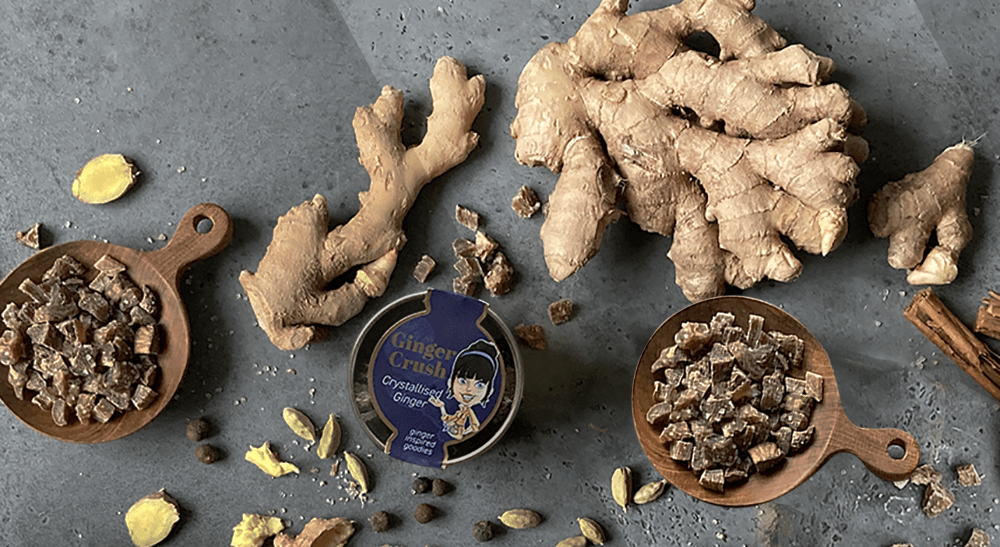
A professional image of what my crystallised ginger looks like now with its packaging

moju-ginger-graph
As you can see from the graph above a company in the UK, Moju Drinks, who produces a range of immune boosting and gut health shoots, did a clinic test with Peruvian ginger, which they use, and Chinese ginger. Ginger root is made up of different phenolic compounds which are mainly gingerol, shogaol and paradols. This medical paper about bioactive compounds and bioactivities of Ginger is very interesting to read - link to paper.
When heat is aaplied to ginger root the shogaol compound increases and adds to the stronger spice level of ginger root. This is why my crystallised ginger offers such a fiery kick. If I sold my crystallised ginger the size of the commercial crystallised ginger, it would put people off. Everyone has varying taste buds and the Peruvian ginger can be intense and for others just normal with a bit of light tingling.
Some other differences with my crystallised ginger compared to the commercial crystallised ginger is that as I use organic ginger root, I give the root a good clean and remove any dried dirty. I remove the skin around the outer tips, as it can be a bit tougher here, and I check for blemishes that look unpleasant. All this skin is then gathered and reboiled in order to harness all the ginger goodness and return it to my production, straining several times to remove particles, always thinking sustainably and zero waste within my business. This infusion adds a nice earthiness to the end result of the ginger syrup. The boiled solution is used in my ginger infused water, which is a by-product of the preparation of the ginger before making the crystallised ginger, and is made into my range of Ginger Syrup, Spiced Ginger Syrup and the seasonal Ginger and Rhubarb Syrup.
...... More to come later. Work in progress, come back later ......
Explore My Crystallised Ginger | A Culinary and Wellness Journey
My journey in the world of business began with ginger – specifically, making crystallised ginger. As a curious food enthusiast, I’m the type who prefers trying out things that are readily available in stores. I’ve even dabbled in making puff pastry from scratch. Though not the greatest result bu still happily edible, I made sausage rolls.
Back in 2017, while living in Canada, I encountered crystallised ginger and that was my light bulb moment. The flavour was palatable, but the excessive sugar content bothered me and I was curious about making it at home.
This marked the beginning of my quest, which naturally started with a Google search – a common approach for many. Eager to learn the process, I delved into the world of homemade crystallised ginger. Numerous results suggested using a mandolin to thinly slice and removing the skin on the ginger. Here’s an example of one of the first pages I checked out, recipe from Daring Gourmet. Eventually, I came across the recipe of a US-based chef named David Lebovitz, known for his culinary expertise on the West Coast of USA. His crystallised ginger recipe intrigued me, which you can find here. What I liked about his recipe was he mentioned about the ginger syrup. Though when I was making the crystallised ginger for the first few times, I didn’t have any syrup leftover in the pot to be using.
To my surprise, the homemade version offered a distinct flavour profile, boasting a vibrant ginger spice kick unlike the perfectly shaped, cubed crystallised ginger. I found myself disheartened by the waste generated from the removing of the skin, especially considering the high fibre content and flavour potential. This aspect prompted me to consider organic varieties. I did see organic ginger from Peru at the Calgary Farmers’ Market and did some further research.

ginger_pregnancy
Of course my google results were different when living in Canada to what google would show me here in Ireland. When I returned to Ireland and once I started looking at commercialising the product. I received some taster feedback and I needed to create a more chewier ginger pieces. After some more searches I came across further information that would help me make the ginger root less fibrous but still oh so good.
As well as the above searches I was looking at the type of ginger and the quality. I was curious of the size and quality of the Peruvian ginger. So once I returned to Ireland, I went looking for some of this golden ginger root. So something to remember if the ginger is nice and yellow that is due to the gingerol concentration, more yellow higher gingerol and goodness, veering towards white/dull colour, low in gingerol.
The commercial crystallised ginger that you see in the supermarkets tend to high have a high volume of sugar per 100g of product, most will range from 75g up to 85g of sugar per 100g of product. Not sure why it is so high when handling such a immune boosting product on its own. I read the below excerpt on how they made the crystallised ginger from a UK business, Suma Wholefoods -
To make sweetened ginger, a number of steps are followed. Firstly, the freshly cut, immature rhizomes are cleaned, then cut into whatever the shape that is needed. Secondly, the ginger is preserved in salt by covering the pieces in salt then covered for 24 hours before the liquid is poured off; next, a fresh load of salt is added, some vinegar is added and the ginger is left to pickle for seven days. Finally, this salted ginger is removed from the brine, washed, then soaked in cold water for two days during which time the water is changed a few times, after which the washed ginger is boiled in water for ten minutes; after this stage, the ginger is boiled in dense sugar syrup several times until the sugary sweetness has impregnated the preserved ginger. For ginger in syrup, the ginger is kept in this dense sugar syrup as preservative. However, for crystallised ginger, it is boiled in the sugar syrup until it has evaporated off further, after which it is drained of the syrup, dried, then rolled in sugar. As much in the spice world, a serious amount of time and labour is expended for very little end value.
You can see it here on this webpage - webpage link
The preparation of the ginger root really losses any beneficial offerings that ginger is so well known for. So it is disappointing to read when seeing about the salting and the addition of the vinegar. I certainly don't do any of those steps to tenderise the root, with research I have been able to take natural steps and produce a far superior product that benefits your health. Obviously the high sugar crystallised ginger has its uses. It's like making good quality chocolate from better sourced ingredients. That is what I am doing with my crystallised ginger.

Some pictures of testing drying crystallised ginger. Just some crystallised ginger drying out au natural.
When I was first making the crystallised ginger to sale, the pieces were a bit larger than what I make now. The flavour was certainly a bit overwhelming for consumers at first or just the unexpected strength, as they would have been accustomed to the sugary crystallised ginger cubes you get in the shop. So making them smaller, customer's are able to enjoy more pieces without blowing their heads off with the ginger zing.
Customer's do acclimatise to the zingy ginger flavour and now take it for the ginger benefits which range from joint issues like arthritis as ginger is a powerful anti-inflammatory. I am hearing more customers mention how the crystallised ginger aids their digestion as it eases acid reflux and heartburn, as well as any nausea symptoms.
So the Peruvian ginger is brought into Ireland mostly through the Netherlands and then redistributed around Europe to other suppliers and distribution companies. Of course having Irish grown ginger would be amazing but the growing conditions for a company like my own whose main ingredients is ginger is just unfeasible at the moment. There are some small organic growers who selling small quantities. There is a grower around Limerick who occasionally grow it, New Leaf Urban Farmers and also locally Poppa Dom's Farm near Kilmullen,near Killarney, have had attempts at growing it. Will get more updates on that soon :).

A professional image of what my crystallised ginger looks like now with its packaging

moju-ginger-graph
As you can see from the graph above a company in the UK, Moju Drinks, who produces a range of immune boosting and gut health shoots, did a clinic test with Peruvian ginger, which they use, and Chinese ginger. Ginger root is made up of different phenolic compounds which are mainly gingerol, shogaol and paradols. This medical paper about bioactive compounds and bioactivities of Ginger is very interesting to read - link to paper.
When heat is aaplied to ginger root the shogaol compound increases and adds to the stronger spice level of ginger root. This is why my crystallised ginger offers such a fiery kick. If I sold my crystallised ginger the size of the commercial crystallised ginger, it would put people off. Everyone has varying taste buds and the Peruvian ginger can be intense and for others just normal with a bit of light tingling.
Some other differences with my crystallised ginger compared to the commercial crystallised ginger is that as I use organic ginger root, I give the root a good clean and remove any dried dirty. I remove the skin around the outer tips, as it can be a bit tougher here, and I check for blemishes that look unpleasant. All this skin is then gathered and reboiled in order to harness all the ginger goodness and return it to my production, straining several times to remove particles, always thinking sustainably and zero waste within my business. This infusion adds a nice earthiness to the end result of the ginger syrup. The boiled solution is used in my ginger infused water, which is a by-product of the preparation of the ginger before making the crystallised ginger, and is made into my range of Ginger Syrup, Spiced Ginger Syrup and the seasonal Ginger and Rhubarb Syrup.
...... More to come later. Work in progress, come back later ......



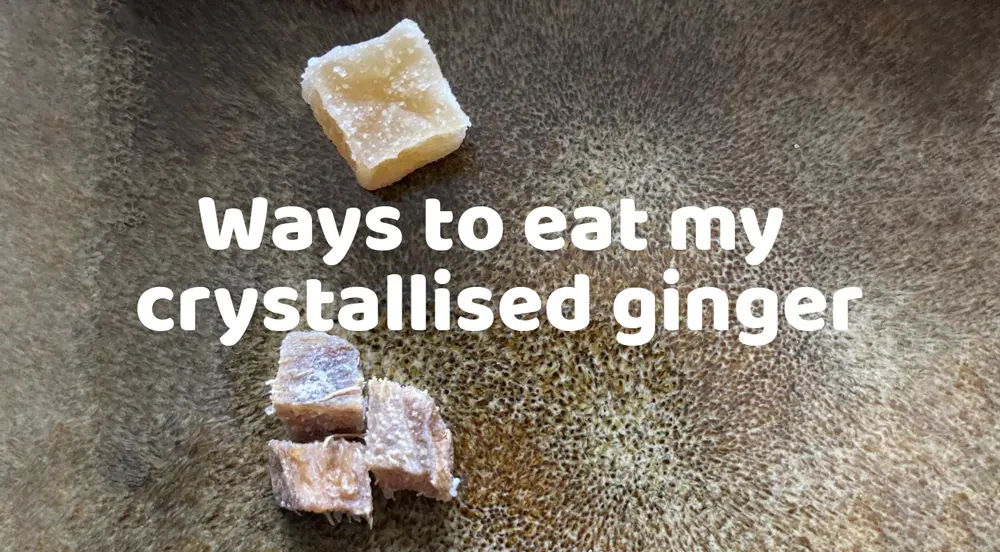




Related Posts
How to make ginger tea with my crystallised ginger
Will ginger help heartburn / acid reflux / GERD?
Ginger effects & Menopause
So why Peruvian ginger?
Welcome to my Ginger Inspired Goodies